Rabat Travel Guide: What to See, Do, and Experience
Rabat, Morocco’s elegant capital city, often flies under the radar compared to its flashier neighbors like Marrakech or Fes but that’s exactly what makes it so special. Nestled along the Atlantic coast and infused with a calm, coastal charm, Rabat offers a harmonious blend of tradition and modernity, history and progress.
As the political and administrative heart of Morocco, Rabat is clean, organized, and refreshingly relaxed. Visitors are drawn to its tree-lined boulevards, wide beaches, and a medina that’s far less chaotic than others in the country. Whether you’re interested in art, architecture, history, or just soaking in the laid-back atmosphere, Rabat delivers a well-rounded and enriching travel experience.
For travelers seeking an authentic Moroccan city that balances cultural depth with a peaceful rhythm, Rabat is an ideal choice.
A Glimpse into Rabat’s History and Heritage
Rabat’s story stretches back to the 12th century, when it was established by the Almohad dynasty as a fortress overlooking the Atlantic. The city’s name comes from the Arabic word “Ribat”, meaning a fortified monastery. It grew in importance under different dynasties and became a haven for Andalusian exiles in the 17th century, enriching its cultural fabric with arts, architecture, and craftsmanship.
Today, Rabat stands as a proud capital blending historical grandeur with modern governance. The Chellah Necropolis, a hauntingly beautiful Roman and Islamic ruin site, offers a window into the city’s ancient past, while the Hassan Tower, an ambitious yet unfinished minaret from the 12th century, reminds visitors of Rabat’s imperial aspirations.
In 2012, UNESCO recognized the city’s exceptional urban and architectural heritage by designating Rabat a World Heritage Site. From its royal palaces and colonial-era architecture to its well-preserved medina and religious landmarks, Rabat is a treasure trove of Moroccan history quietly impressive and deeply significant.
Top Things to Do in Rabat
While Rabat is more low-key than other Moroccan cities, it’s packed with impressive sites and cultural gems. Whether you’re wandering through ancient ruins, relaxing by the sea, or diving into the city’s modern art scene, there’s plenty to explore.
Hassan Tower and Mausoleum of Mohammed V
This iconic site is Rabat’s most famous landmark. The Hassan Tower, a 12th-century minaret, was part of a grand mosque that was never completed. Its reddish stone structure and nearby columns make it a stunning place to walk around and photograph.
Right next door, the Mausoleum of Mohammed V is a masterpiece of Moroccan architecture. The white marble tomb houses the remains of King Mohammed V and his sons, and the interior is adorned with zellij tilework, carved plaster, and gold leaf detailing.
Tip: Entry is free, and respectful dress is recommended.
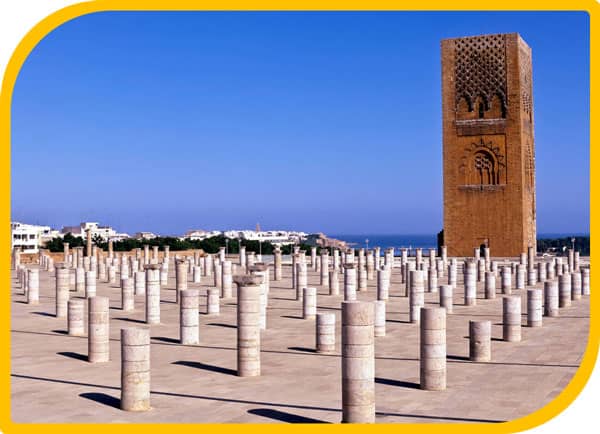
Kasbah of the Udayas
Perched high above the Atlantic, the Kasbah of the Udayas is a serene escape wrapped in sea breeze and centuries of history. Step through the majestic Bab Oudaia gate, and you enter a peaceful world of whitewashed walls, cobalt-blue doors, and winding alleyways bathed in soft light.
This old fortress, once a stronghold of warriors and pirates, now hums with quiet charm. Lose yourself in its Andalusian-style streets, where potted flowers spill from windowsills and every corner offers a postcard view.
Pause in the lush Andalusian Gardens, where orange trees and fountains create a cool, fragrant retreat. Visit the small museum tucked inside the kasbah to discover traditional Moroccan art, textiles, and instruments that echo the soul of the city.
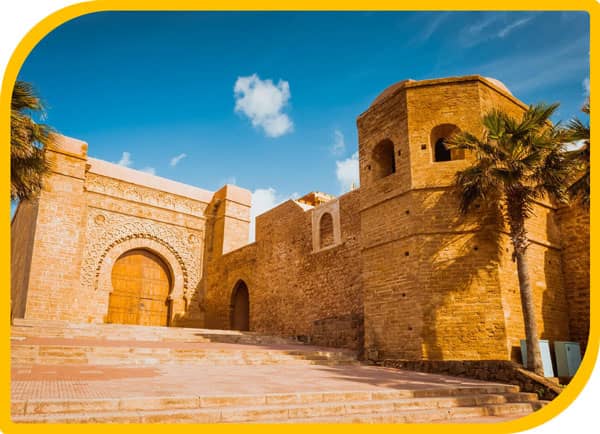
Chellah Necropolis
Chellah is a hauntingly beautiful sanctuary where time seems to stand still. Perched on the edge of Rabat, it blends Roman ruins with graceful traces of Islamic architecture, wrapped in wild greenery and silence.
Overgrown with wildflowers and watched over by nesting storks, the site feels both ancient and strangely alive. Cracked mosaic tiles, vine-covered columns, and the solemn remains of a mosque, minaret, and royal tombs tell stories of centuries gone by.
As you wander through its crumbling paths, a soft breeze carries the whispers of history. This is one of Rabat’s most atmospheric and poetic places—a haven for dreamers, photographers, and lovers of forgotten worlds.
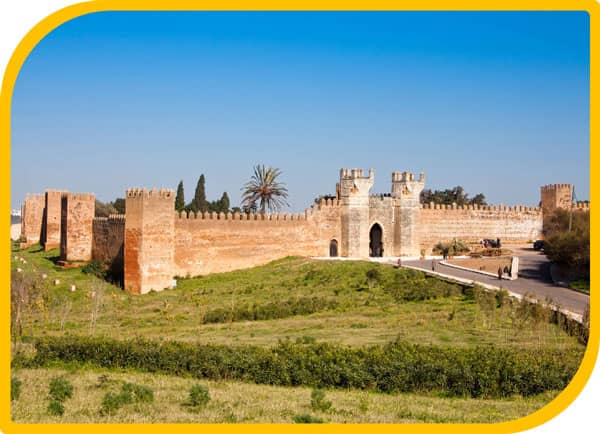
Rabat Medina and Rue des Consuls
Step into the heart of Rabat’s old city, where history and daily life blend seamlessly. The Medina of Rabat is a calm and charming alternative to the bustling souks of Fes or Marrakech. Its streets are easy to navigate, making it ideal for relaxed exploration.
Stroll along the historic Rue des Consuls, once home to foreign diplomats, now lined with stalls offering handmade carpets, antiques, leather goods, jewelry, and artisan crafts. The atmosphere is friendly and welcoming, with minimal hassle from vendors.
Beyond shopping, the medina offers a genuine glimpse into local daily life. You’ll find spice shops, cafés, and quiet corners where locals go about their routines. It’s a place where tradition and modernity coexist, perfect for curious travelers and photographers alike.
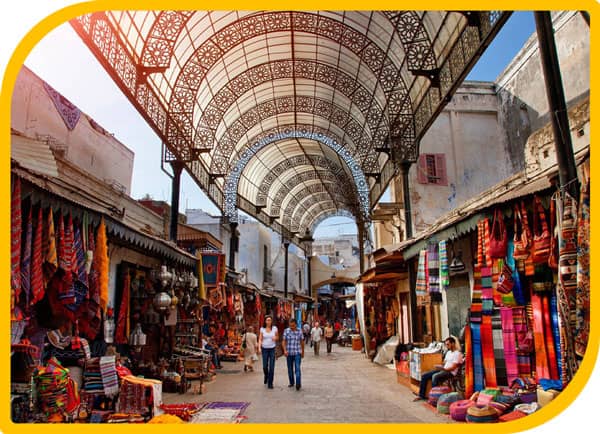
The Rabat Zoo (Jardin Zoologique National)
Nestled just outside the city center, the Rabat Zoo offers a refreshing escape into the wild. Ideal for families, students, and nature lovers, this national zoological garden is more than a place to see animals it’s a journey through Africa’s diverse ecosystems.
Spread across a beautifully landscaped area, the zoo is home to lions, elephants, crocodiles, monkeys, and rare antelope species, including the endangered addax. Themed zones from savannas and wetlands to deserts and rainforests immerse visitors in the habitats of the continent’s most iconic wildlife.
Recognized for its conservation efforts and educational outreach, the Rabat Zoo is a modern and thoughtfully designed space, offering a peaceful break from the city’s historic landmarks. It’s a place where curiosity and wonder meet.
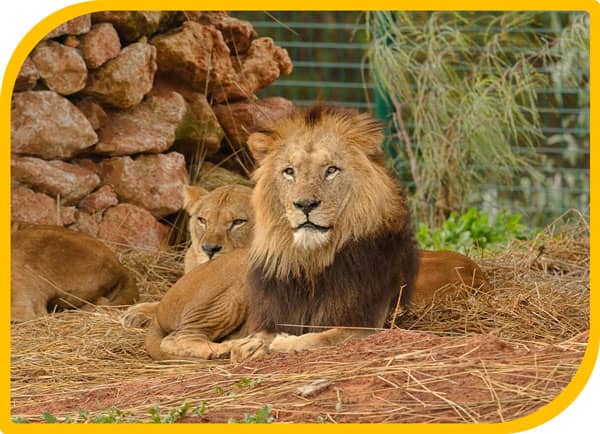
UNCOVER THE ELEGANCE OF RABAT THROUGH A CULTURAL ADVENTURE
Step into Morocco’s sophisticated capital with our exclusive Rabat Cultural Tour. Explore grand royal palaces, wander through the lush Andalusian Gardens, marvel at ancient ruins, and dive into a city where modern elegance meets timeless heritage at every turn.
Beaches, Gardens, and Outdoor Attractions in Rabat
Rabat offers a refreshing dose of nature alongside its cultural treasures. With its Atlantic coastline, manicured gardens, and green public spaces, the city invites travelers to relax and recharge in scenic surroundings.
Rabat’s Beaches
Just a short walk from Rabat’s city center, Plage de Rabat and Plage de Salé offer wide stretches of golden sand along the Atlantic coast. These beaches are popular with locals who come to surf the strong waves, sunbathe, or enjoy long walks by the water. Swimming can be risky due to rough currents, but the refreshing ocean breeze and beautiful sunsets make it worth visiting. In summer, the beaches come alive with families playing football, food vendors selling traditional treats, and groups gathering to relax. The blend of natural beauty and lively local culture creates a welcoming atmosphere. Whether you’re seeking adventure on the waves or a peaceful moment by the shore, these beaches provide a perfect coastal escape near the city. Their vibrant yet relaxed vibe captures the spirit of Rabat’s seaside life.
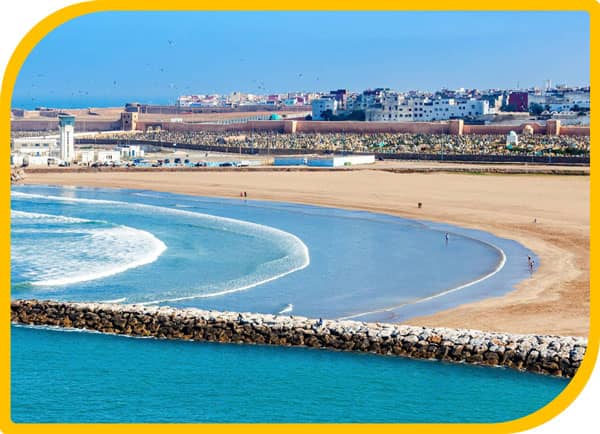
Andalusian Gardens
Nestled inside the historic Kasbah of the Udayas, the Andalusian Gardens offer a peaceful retreat from Rabat’s busy streets. The gardens are filled with fragrant orange trees, tall palms, and vibrant bougainvillaea, creating a shaded oasis perfect for relaxing, reading, or taking photos. Built in the 20th century by the French, the gardens showcase a harmonious blend of Moroccan and Andalusian design. Visitors can wander along serene walkways, admire elegant fountains, and rest on beautifully tiled benches tucked among lush greenery. This tranquil spot combines history, nature, and art, making it a must-see for anyone exploring Rabat. The gardens’ calm atmosphere provides a refreshing contrast to the city’s lively energy, inviting visitors to slow down and enjoy quiet moments.
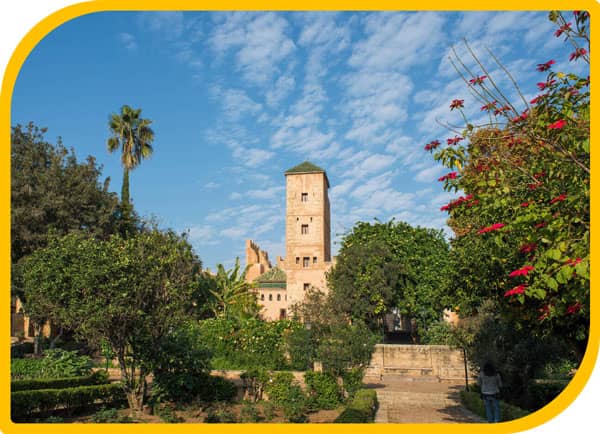
Exotic Gardens of Bouknadel
Located just a short drive from Rabat, the Exotic Gardens of Bouknadel are a serene hidden gem. Created in the 1950s by a French horticulturist, these gardens showcase a rich collection of tropical plants, bamboo groves, and calming water features. Visitors can explore themed pavilions representing different parts of the world, adding an international flair to the lush landscape. The gardens provide a peaceful escape for nature lovers, families, and travelers looking to relax and unwind. With winding paths and vibrant greenery, it’s an ideal spot for leisurely strolls and photography. The Exotic Gardens offer a refreshing contrast to city life, inviting visitors to immerse themselves in diverse flora and tranquil beauty. It’s a perfect day trip destination near Rabat for anyone seeking nature and calm.
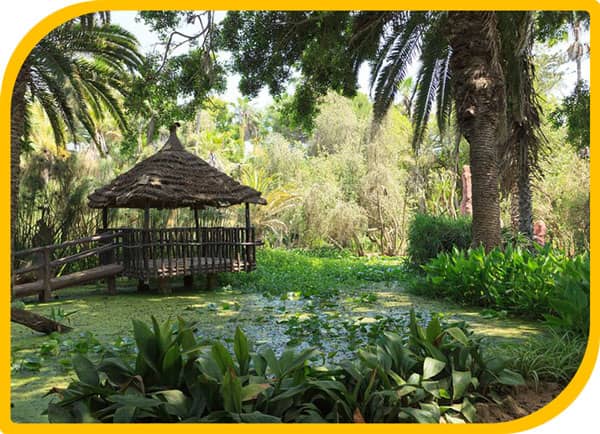
Corniche and Coastal Walks
Rabat’s Corniche stretches along the waterfront, offering stunning ocean views and space for jogging, biking, or peaceful walks. It’s especially beautiful in the late afternoon when the sun begins to set over the water.
Stop by a seaside café, watch the waves crash below the cliffs, or simply breathe in the fresh sea air.
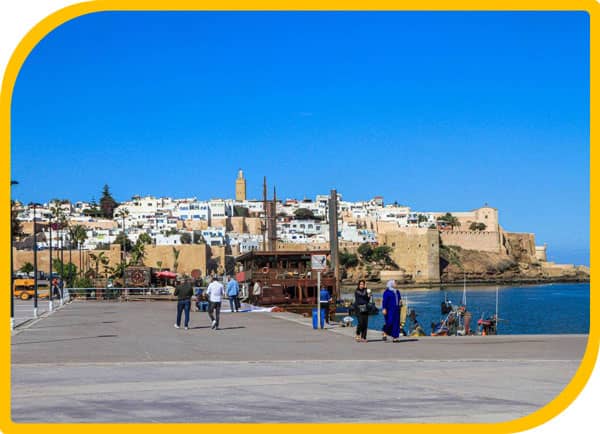
Where to Stay in Rabat
Rabat offers a wide range of accommodations that suit every traveler’s style and budget. Whether you’re looking for a traditional riad in the medina, a modern hotel in the city center, or a coastal retreat near the ocean, Rabat has something for everyone.
Budget-Friendly Options
For backpackers and budget-conscious travelers, Rabat has a selection of affordable guesthouses and hostels offering comfort, cleanliness, and Moroccan hospitality. These places are often located in or near the old medina and come with shared lounges, free Wi-Fi, and basic amenities.
What to Expect:
- Price range: 100–250 MAD (£8–£20) per night
- Simple rooms, sometimes with shared bathrooms
- Friendly local hosts and great locations for walking
Mid-Range Riads and Boutique Stays
Rabat’s riads are beautifully restored traditional homes with interior courtyards, local décor, and a peaceful atmosphere. Many of them blend authentic Moroccan architecture with modern comforts, offering a unique and cozy experience.
What to Expect:
- Price range: 300–800 MAD (£24–£64) per night
- Private rooms with ensuite bathrooms
- Often includes breakfast and a rooftop terrace
- Located in the heart of the medina or just outside
Upscale Hotels and Luxury Stays
If you’re seeking indulgence, Rabat has several 4- and 5-star hotels with top-notch services and modern design. These are perfect for business travelers, couples on a romantic getaway, or anyone who wants a little extra comfort.
What to Expect:
- Price range: 900–2,500 MAD+ (£72–£200+)
- Spa services, pools, fine dining, and concierge help
- Convenient access to major attractions and business centers
Food Scene and Local Cuisine in Rabat
Rabat’s culinary scene is a tasteful blend of traditional Moroccan flavors and modern influences. As the capital city, it offers everything from humble street food stalls and authentic local eateries to trendy cafés and upscale dining experiences. Whether you want to try a steaming bowl of harira or indulge in gourmet reinterpretations of Moroccan classics, Rabat won’t disappoint.
Traditional Moroccan Dishes
In Rabat, you’ll find beloved Moroccan staples served with pride. Be sure to try:
- Tajine: Slow-cooked stew made with chicken, lamb, or fish, along with vegetables and spices.
- Couscous: Usually served on Fridays with meat, vegetables, and chickpeas.
- Harira: A rich tomato-based soup with lentils and chickpeas popular during Ramadan but available year-round.
- Pastilla: A savory-sweet pie traditionally made with pigeon or chicken, almonds, and cinnamon wrapped in thin pastry.
You can enjoy these dishes in local diners or traditional restaurants nestled in the medina.
Street Food & Quick Bites
Rabat’s street food is affordable, fast, and flavorful. Look out for:
- Msemen and Harcha: Moroccan flatbreads often sold at breakfast stalls or markets.
- Brochettes: Grilled meat skewers served with fresh bread and spicy harissa.
- Sandwiches: Made with sardines, chicken, or kefta (spiced ground beef), usually served in French-style baguettes.
- Fresh Juices: Orange, pomegranate, and avocado shakes are widely available and refreshing.
These can be found in areas like Avenue Mohammed V or near the medina gates.
Cafés and Modern Dining
Rabat has a growing number of modern restaurants and cafés catering to both locals and expats. You’ll find:
- Chic cafés offering Moroccan-fusion dishes, vegetarian meals, and pastries
- Seaside restaurants serving fresh grilled fish and seafood platters
- International cuisine including French, Italian, Japanese, and Middle Eastern options
Many of these spots have stylish decor, Wi-Fi, and ocean views great for digital nomads or relaxed afternoons.
UNCOVER THE ELEGANCE OF RABAT THROUGH A CULTURAL ADVENTURE
Step into Morocco’s sophisticated capital with our exclusive Rabat Cultural Tour. Explore grand royal palaces, wander through the lush Andalusian Gardens, marvel at ancient ruins, and dive into a city where modern elegance meets timeless heritage at every turn.
Transportation and Getting Around Rabat
Getting around Rabat is relatively easy thanks to its compact size and well-organized transport options. Whether you prefer public transport, taxis, or renting a car, you’ll find convenient ways to explore the city and its surroundings.
Public Buses
Rabat’s bus network connects key areas of the city, including the medina, train stations, and residential neighborhoods. Buses are affordable and run regularly, making them a budget-friendly option for tourists.
- Cost: Around 4 MAD (£0.30) per ride
- Tips: Look for buses operated by the Alsa company; tickets are purchased on board.
Petit Taxis
Petit taxis are small, usually red, and ideal for short trips within Rabat. They are metered but sometimes you may need to negotiate the fare before starting the ride.
- Typical fares: 7–20 MAD (£0.60–£1.70) depending on distance
- Tip: Always confirm the price or ask the driver to use the meter.
Grand Taxis
For longer trips outside the city, grand taxis (larger vehicles often shared by multiple passengers) are used. These are common for routes to nearby towns or for airport transfers.
- Cost: Varies by distance, usually around 50–150 MAD (£4–£12)
Walking and Cycling
Rabat’s relatively flat landscape and pedestrian-friendly areas make walking an enjoyable way to see the city. Many attractions are within walking distance, especially in the medina and along the Corniche.
Cycling is gaining popularity, and there are bike rental shops offering hourly or daily rates.
Car Rentals
Renting a car gives you freedom to explore beyond Rabat at your own pace, including trips to nearby cities like Casablanca, Fes, or Chefchaouen. International and local car rental companies operate in Rabat.
- Cost: Starting at about 200 MAD (£16) per day, depending on the vehicle
Best Time to Visit Rabat
Choosing the right time to visit Rabat can enhance your experience and help you avoid crowds or extreme weather. The city enjoys a Mediterranean climate, with mild, wet winters and warm, dry summers.
Spring (March to May)
Spring is one of the best times to visit Rabat. The weather is pleasantly warm, with temperatures ranging from 17°C to 24°C (63°F to 75°F). Flowers bloom in the gardens, and the city feels vibrant but not crowded. It’s ideal for sightseeing, outdoor activities, and festivals.
Summer (June to August)
Summers can be hot, with temperatures often reaching 30°C to 35°C (86°F to 95°F). However, Rabat’s coastal location means it’s usually cooler than inland cities like Marrakech or Fes. The beaches and Corniche are popular spots to cool off. Expect more tourists, especially in July and August.
Autumn (September to November)
Autumn offers mild weather, like spring, with temperatures between 20°C and 28°C (68°F to 82°F). The city’s gardens remain lush, and it’s a comfortable time to explore without the summer heat. September is still busy with tourists, but October and November see fewer visitors.
Winter (December to February)
Winters in Rabat are mild but wetter, with temperatures ranging from 12°C to 18°C (54°F to 64°F). Rain is more frequent, but it rarely disrupts travel plans. This is the low tourist season, making it a peaceful time to visit historical sites and museums.
Final Tips for Visiting Rabat
To make the most of your trip to Morocco’s capital, keep these helpful tips in mind:
- Dress modestly: Morocco is a conservative country. Wearing modest clothes respectful of local customs helps you blend in and shows cultural sensitivity.
- Learn basic Arabic or French phrases: While many people in Rabat speak some English, knowing simple greetings and phrases in Arabic or French can enhance your interactions.
- Stay hydrated: The climate can be warm, so always carry a bottle of water when exploring.
- Use official taxis: To avoid scams, use licensed petit and grand taxis and agree on prices beforehand if the meter is not used.
- Be cautious with photography: Always ask permission before photographing people, especially in traditional neighborhoods or markets.
- Respect local customs: During Ramadan or religious holidays, be mindful of local practices, such as refraining from eating or drinking in public during daylight hours.
- Plan your days: Start early to explore popular sites before the crowds and afternoon heat.
Rabat offers a wonderful blend of history, culture, and modern life with these tips, your visit will be smooth and memorable!
Conclusion
Rabat, Morocco’s vibrant capital, beautifully balances its rich history with modern charm. From the ancient walls of the Kasbah of the Udayas to bustling markets and peaceful seaside promenades, the city offers a diverse range of experiences for every traveler. Whether you’re wandering its historic medina, savoring traditional Moroccan cuisine, or simply soaking in the coastal breeze, Rabat invites you to discover a side of Morocco that’s both authentic and welcoming.
With its accessible location, friendly atmosphere, and wealth of cultural treasures, Rabat is a must-visit destination that promises lasting memories. Plan your trip thoughtfully, and you’ll uncover the hidden gems and timeless beauty that make Rabat truly special.

